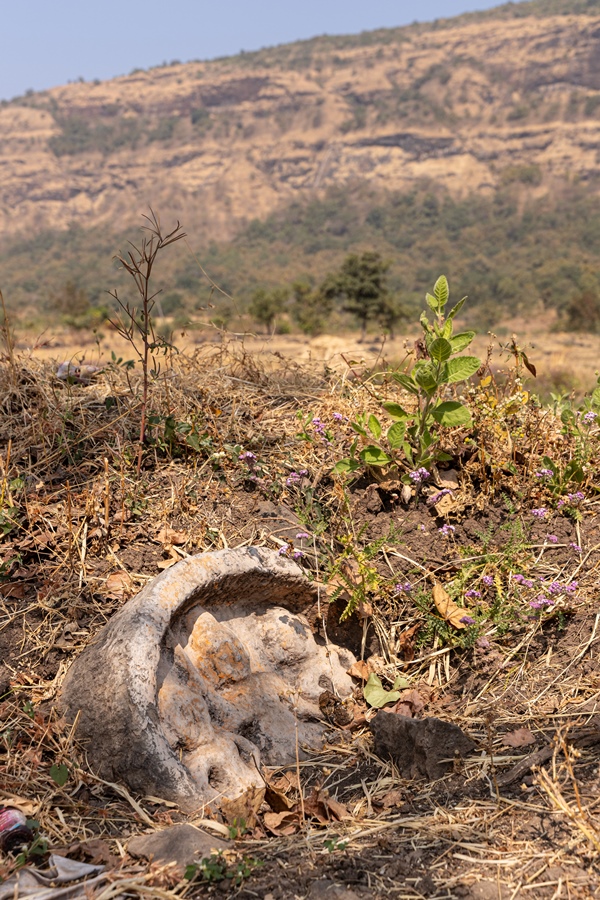
Located 15km east of Pale and Uksan Cave, and 14km north-east of Kamshet, Nigade Caves are another example of a lesser-known ancient cave site that has thus far received very little attention from scholars. Visiting the caves requires a bit of a trek, so at least half a day should be set aside for such an adventure. Combining Nigade with Pale and Uksan is easily possible in a single day provided you make an early start.



The trek to the caves starts from the north-east side Nigade village, from where you get a clear view of your destination far away on the cliff face. If you’re traveling by car you won’t be able start the trek very far away from the village, if you’re on a motorbike it would probably possible to get a little closer via the very rough dirt tracks run up to the base of the hill.

The trek itself can be split into three distinct sections. The first section takes around 30 mins walking across flat open farmland. The mid section is the most difficult, as you enter dense forest and start to ascend the very steep hill. One stretch here requires you negotiate quite an exposed iron ladder, we had ropes as a precaution but they weren’t utilized. Just prior to the ladder the landscape starts to open up as you leave the forest, with some rock-cut steps aiding your ascent. This hilly section of the trek takes around 45 mins.




Finally you reach a ledge about halfway up the cliff-face, from where you turn right (south-east) and traverse along the precipice to explore the caves and other excavations. Suffice to say any attempt to do this trek in the wet would be foolish, and with hardly any noticeable path in the forested mid-section, a guide is also essential. It takes around 15 mins to carefully walk the entire length of this ledge, not taking into account any stops.
The first excavation you will come across is actually a little higher up the cliff face and is today inaccessible. It appears to be a single cell, and with no obvious socket holes in the wall of the cliff I can only assume this was once reached via a ladder, or the cliff face as subsequently eroded away any hint of an access route. All along this cliff face there are other cavities at a higher level, but none of them have been squared-off like this one.


All the remaining known excavations are accessible from the ledge, the first one you come to is in fact the largest. The wonderfully flat chiseled ceiling is in stark contrast to the walls of the cave that are extremely rough, so I would assume this cave was intended to be a hall and was never completed. A sort distance into the cave is a carved front wall and doorway. Neither wall either side of the doorway extends to the ceiling, nor does it appear to have ever been the case, so it’s hard to determine if these elevations ever extended higher than they are today.





Continuing along the ledge, the next set of of features are a series of rock-cut water cisterns, all still housing water, but I’m not sure the quality of that water would be very good today (at least, not in January).



Finally you come to a small temple above another series of water cisterns. The temple is dedicated to Padmavati, known locally as Padubai, Nigade Caves is sometimes referred to as Padmavati Caves on account of this deity. Unlike some of the other excavations along the ridge which were strewn with litter, this small and simple temple/shrine is well maintained and clearly visited frequently by locals.



The sweeping views across the pains from this vantage point are simply stunning, even on a hot and hazy day. It makes the effort of the trek a far off distant memory.
As far as I can tell there has been no formal academic study of the excavations at Nigade, and with the absence of any iconography or inscription, there’s little to go on to determine the antiquity or religious beliefs of those who once took shelter here.


That concluded my trek up to Nigade Caves, a great half day trip that I can thoroughly recommend. Please do not attempt this trek when it is wet, ensure you have a guide with you and plenty of water/snacks, and be aware that there are a number of curious/brave monkeys that frequent the area, so keep all your belongings close to you.





My thanks to Vivek Kale and Sai Upalekar for showing me the caves and accompanying me.
Please ‘Like’ or add a comment if you enjoyed this blog post. If you’d like to be notified of any new content, just sign up by clicking the ‘Follow’ button. If you have enjoyed this or any other of my posts, please consider buying me a coffee. There’s a facility to do so on the righthand side of this website for desktop users, and just above the comment section for mobile users. Thank you !
If you’re interested in using any of my photography or articles please get in touch. I’m also available for any freelance work worldwide, my duffel bag is always packed ready to go…
KevinStandage1@gmail.com
kevinstandagephotography.wordpress.com
Categories: India, Maharashtra, Nigade (Padmavati) Caves





Thank you for showing us the astonishing Nigade | Padmavati Caves in Mahaarashtra. Maharashtra, revealing unknown aspects of early Buddhist culture.
LikeLiked by 1 person
Special place; thanks for showing.
LikeLiked by 1 person